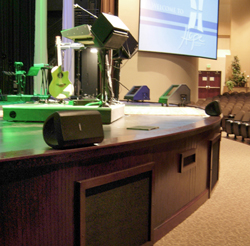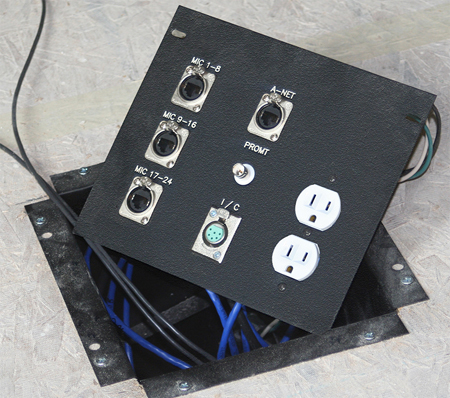
The easy answer: Provide an excess of wire and conduit from the platform to the control area(s). Not just to the mixing console, but also to video rooms and studios, if they already exist or if there is discussion about having them in the future.
This is not to say that you should have 400 mic lines running all over the place. (Who’s to say what type of mic lines will be standard in the future, anyway?)
But build in the flexibility to run individual lines, snakes, fiber, data, or whatever else may be encountered now and in the future. Make sure there are several empty conduits planned for your new or refitted auditorium; it’s cheap to do it now, but very expensive to add later.
Note that not all wires can be next to each other. Some electrical contractors may ask if it’s okay to use PVC instead of steel conduit, and the answer is use steel. Steel provides magnetic shielding for electrical wiring. (PVC does not.) Using steel goes a long way toward eliminating nasty buzzes and hums.
However, if the budget dictates PVC, make sure it’s located as far as possible from electrical and other wiring (yards and yards, not feet! Don’t let the electrician use the argument that two trenches in the sub floor will be needed.
Route different kinds of cable as far apart as possible if you must use PVC. And, always keep mic, loudspeaker, video, data, and whatever other cabling in separate conduits, whether they’re PVC or steel.
Other Features
Floor boxes are your friends, and wall panels and plates can be a welcome substitute for floor boxes as long as cables running from the wall plates to the location where they are being used won’t create tripping hazards.
My recommendation has been boxes/panels placed strategically around the perimeter of the platform. Install as many as possible, but keep them invisible from the seating areas. Also remember that it’s important to be able to get cables outside of the “performance area” as quickly as possible.
Now, let’s fill those floor boxes/plates. Each box generally contains 6-12 jacks. Keep things organized with simple numbering: Box “A” jacks are numbers 1-12, Box “B” are numbers 13-24, and so on.

You can have literally hundreds of sound system inputs at the platform, divided between the boxes, without being excessive and without confusion. Jacks can accommodate a variety of inputs and output s for other systems/uses as well, such as AC power, video, data, etc.
Drop snakes can also serve useful purposes. A drop snake simply takes the inputs in each box and links them to a new location on the platform. With a multi-pin connector-style snake, you place a multi-pin connector in each floor box that duplicates the input of that box. (A multi-pin connector puts all of these lines into one connection, locking into place via a connector of the opposite “gender.”)

